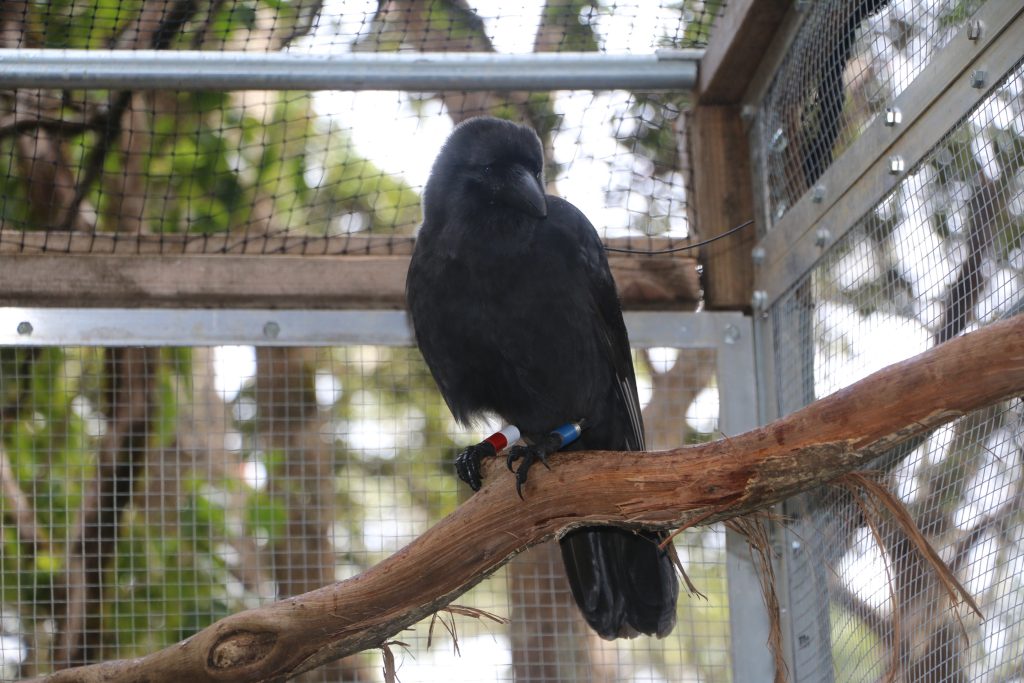Historic first release of ʻAlalā on Maui
Hawaiian crows known as ʻalalā are once again flying free and sounding calls in the forests of Hawai‘i, after coordinated efforts and extensive planning.
A pilot release of five ʻalalā recently occurred on the leeward slopes of Haleakalā, in the Kīpahulu Forest Reserve on Maui. This cooperative effort is a historic first release of Hawaiʻi’s endemic crow on Maui and the first reintroduction attempt outside of Hawaiʻi Island.
Partners including the Maui Forest Bird Recovery Project (MFBRP), San Diego Zoo Wildlife Alliance (SDZWA), and the US Fish and Wildlife Service, along with the DLNR Division of Forestry and Wildlife (DOFAW), worked tirelessly on breeding, caretaking, logistics and community outreach to bring this vision to reality.
“We understand how valuable ʻalalā are as a cultural resource as well as a biological resource,” said Martin Frye, research field supervisor for MFBRP. “They play a huge role in Hawaiian culture just as much as they do in the Hawaiian forest. Those two things are linked.” As seed dispersers of numerous native plants, the revered ʻalalā and forests are interconnected. The messages: E Hoʻolāʻau Hou ka ʻAlalā (May the ʻalalā thrive once again in their forest home) and No kākou ke kuleana (The responsibility belongs to us) speak to a shared vision and project goal that includes biologists, staff and the greater community.
This latest project iteration has taken more than two years of planning, research and refinement, but the journey to preserve ʻalalā has a much longer history. The impact of past conservation leaders is still felt today, including that of Dr. Fern Duvall, a former Maui Nui program manager with DOFAW who worked on ʻalalā recovery since the 1980s.
ʻAlalā are considered ʻaumākua (spirit guardians) in Hawaiian culture. Frye shared, “The birds represent so many individuals who have gone before us and our care for this release group is linked with our desire to preserve their memories and knowledge for the future.” Duvall and others dreamed of a day when ʻalalā would inhabit Maui’s forests for its prime habitat, variety of food sources and the absence of ‘io (Hawaiian hawk), a predator of the species.
Building upon lessons from previous releases on Hawaiʻi Island in the 1990s and more recently from 2016–2019, biologists and staff from past and present have contributed to making this shared vision a reality, pivoting to the Valley Isle for this reintroduction. Insights from earlier efforts helped to shape the current project’s design, including the cohort of birds selected for release.
Three male and two female juveniles were selected for this initial release, as young birds are less territorial than adults and staff expects more group cohesion, teamwork and learning from one another as a result. These particular individuals were selected for their highly developed social and behavioral skills that may allow them a greater likelihood to succeed in the wild at foraging, predator avoidance and pair bonding.
Two additional design elements unique to the Maui release are automated feeder boxes and Global Positioning System (GPS) tracking. The feeders are able to distribute food on-demand as a supplement to the birds’ wild diet. The GPS transmitters provide a second method to track the birds in addition to VHF radio telemetry. These small, light GPS trackers are attached to a durable cloth harness worn by the ʻalalā as a backpack.
The birds spent several weeks in a field aviary at the release site learning to use the feeders and getting accustomed to wearing their new backpacks. The dedicated team of biologists and staff watched over the ʻalalā during this time and poured themselves, physically and emotionally, into providing the best environment and care for these birds.
“This pilot release marks a significant milestone for ʻalalā, showcasing our commitment to their recovery,” said Chelsie Javar-Salas, supervisory U.S. Fish and Wildlife Service biologist for the Pacific Islands Fish and Wildlife Office. “While we acknowledge that there is more work to be done, our focus is currently on closely monitoring these birds to ensure they have the best opportunities to thrive in their new home in east Maui.”
The morning of the release and the days leading up to it brought heightened emotions for the field crew. Opening the aviary door signified both joy and apprehension – a tradeoff for the birds from safety and security to freedom and uncertainty. Despite the best plans and intentions, there is always risk. Staff are optimistic that the birds’ exceptional intelligence and instincts, and the cohesion of the group will bode well for their chances of surviving and thriving.
One by one, the ʻalalā moved beyond the threshold of the aviary doorway and into the unknown. The birds initially stayed close to the aviary, walking on its frame and roof before maneuvering from tree to nearby tree. Soon enough, they were spreading their wings a bit more and surveying their new reality, vocalizing to each other, and putting their new forest neighbors on notice that they had arrived. “As much as we strive at our centers to provide them with the best possible conditions, this is the home they deserve,” said Gavin Nuttall, SDZWA avian recovery specialist. As his emotions welled up, he added, “Opening the door and seeing these birds flying free meant so much.”
Success for the project relies on how the birds manage to adapt to their new home and can only be measured over time. The field team will continue to monitor the birds into the foreseeable future, supplementing their food and keeping an eye on their health and wellbeing. For now, the birds are free to roam and explore their surroundings, learning and feeling what it means to be wild.




























